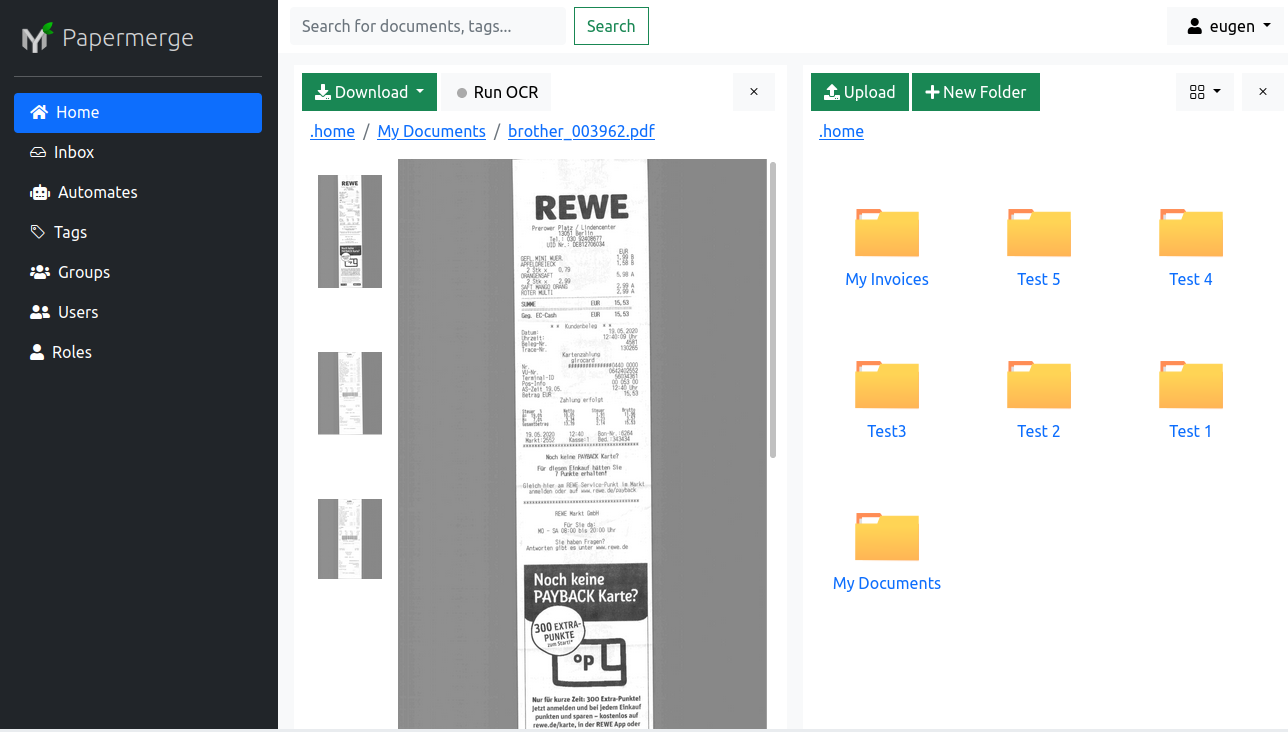 | submitted by /u/bmullan to r/LXD [link] [comments] |
Actionable
Ideas found online, where I’ve defined an action to be taken.
[link] [comments]
The idea for an Ansible reference (or cheat) sheet was reborn last week at the Linuxhotel; a few students who knew they would be receiving a tmux mug as a gift when leaving asked why we don’t give out Ansible mugs.
One person approached me and said mugs are impractical: most people already have their favorite beverage mug, mugs have little space for information, and they typically find their way into the back of some kitchen cabinet. Why don’t we consider a nicely-printed DIN A3 sheet on good (plastified) paper? I thought that a good idea.
And so began the work of gathering the information I wanted to present and packing it onto a double-sided A3 page. I’d have very much liked to add details for our advanced course, but there’s simply not enough space on these two pages. (If your eye sight is very good you might be able to read it when printed on A4.)
So, here’s the reference card, and please let me know if you have feedback.
One of the most useful DNS and DNSSEC debugging utilities I am aware of is DNSViz – a tool for visualizing the status of a DNS zone:
it provides a visual analysis of the DNSSEC authentication chain for a domain name and its resolution path in the DNS namespace, and it lists configuration errors detected by the tool
It has enabled me to to “see” issues with domains which are otherwise very difficult to determine, and it is a site I strongly recommend in DNS/DNSSEC courses.

DNSViz presents a domain on a Web page and I can hover over individual elements to see details about them, as the example above demonstrates. (See the full output here.) Domains are typically visualized from the root down to the domain I wish to test. DNSViz keeps a history (which was unavailable for a long time) so I can “walk back” in time looking at previous analyses.
DNSViz is also exciting to use on your own DNSSEC-signed domains, and note that this excitement extends to a possible requirement for smelling salts: will the page display portions in red (i.e. bogus or kaputt)?
That was not a joke. :-)
I wanted to try DNSViz in a self-hosted environment, as the software is open source, and opted for the easiest mechanism: a docker image.
I also cloned the dnsviz/dnsviz repository as I later discovered the program can produce the “HTML format”, i.e. exactly the view we see on at DNSViz, and I copied the required CSS and JS files into their own directory:
$ ls -1 web/
dnsviz.css
dnsviz.js
jquery-1.11.3.min.js
jquery-ui-1.11.4.custom.min.css
jquery-ui-1.11.4.custom.min.js
raphael-min.js
Then I assembled the commands (probe, graph) needed to produce the PNG, and HTML (SVG is also possible), and massaged the HTML to use the assets from the web/ directory:
#!/usr/bin/env bash
z=jpmens.net
docker run --network host -v "$PWD:/data:rw" dnsviz/dnsviz \
probe -A -a . --nsid --pretty-output -o $z.json $z
docker run -v "$PWD:/data:rw" dnsviz/dnsviz \
graph -r $z.json -T png -O
docker run -v "$PWD:/data:rw" dnsviz/dnsviz \
graph -r $z.json -T html -O --rr-types SOA,NS
sed -I "" -e 's,file:///usr/share/dnsviz/css,web,' \
-e 's,file:///usr/share/dnsviz/js,web,' $z.html
And I have the program generate the visualization:
$ ./run.sh
Analyzing .
Analyzing net
Analyzing jpmens.net
The resulting PNG and HTML differ here, because for the HTML I’ve limited the RR types to SOA and NS, but otherwise they contain the same information. The probe phase produces a JSON file containing serialized responses to queries for the specified domain.
I can specify my own resolvers, ask the program to query authoritative servers only, and use the “print” subcommand to assess specified domain names based on the content in the JSON file. If need be, I can also use an alternate trust anchor, permitting the tool to be used in private roots as well.
I thought interesting what Guillaume-Jean Herbiet mentioned to me: they use a self-hosted version of DNSViz to test the semantic validity of signed zones before publication.
I then install the program so that I no longer need docker.
$ brew install dnsviz graphviz
Peter DeVries points out that the tool also has a “query” command which gives textual results which are relatively easy to understand. In the following example I query for a domain and we see then chain of trust from the root (.) down through (net) to the zone I’m interested in:
$ dnsviz query jpmens.net
. [.]
[.] DNSKEY: 8/951/256 [.], 8/18733/256 [.], 8/20326/257 [.]
[.] RRSIG: ./Algorithm.RSASHA256/20326 (2022-12-20 - 2023-01-10) [.]
net [.] [.]
[.] DS: 8/35886/2 [.]
[.] RRSIG: ./Algorithm.RSASHA256/18733 (2022-12-22 - 2023-01-04) [.]
[.] DNSKEY: 8/57635/256 [.], 8/35886/257 [.]
[.] RRSIG: net/Algorithm.RSASHA256/35886 (2022-12-20 - 2023-01-04) [.]
jpmens.net [.] [.]
[.] DS: 13/37440/2 [.]
[.] RRSIG: net/Algorithm.RSASHA256/57635 (2022-12-19 - 2022-12-26) [.]
[.] DNSKEY: 13/17125/256 [.], 13/37440/257 [.]
[.] RRSIG: jpmens.net/Algorithm.ECDSAP256SHA256/37440 (2022-12-15 - 2023-01-14) [.]
[.] A: 185.26.156.73
[.] RRSIG: jpmens.net/Algorithm.ECDSAP256SHA256/17125 (2022-12-10 - 2023-01-09) [.]
Did I mention DNSViz is a brilliant tool?
More and more frequently, when I ask friends and family (people with a mainly non-computing background) how they manage their passwords their eyes cloud over, and I then feel the need to tell them that they ought to apply good password hygiene. (I tend to mensplain a bit.) As such I’ve been looking much more deeply into KeePassXC as a multi-platform, Open Source, and very decent password manager.
I ran away from 1Password many years ago when, IIRC, forced cloud upon their users and also converted to a subscription model and settled for EnPass at the time. Aside from a number of UI quirks in EnPass I’ve been happy enough with it, and I got it at the time when they had a purchase model; I believe that has meanwhile also changed to a subscription model. I want to be able to recommend a program which has a fixed price (Open Source is fine) and a UI which will hopefully remain somewhat consistent. I think KeePassXC matches the requirement.
These notes are intended as a reminder to myself of the features and possibilities I discovered in KeePassXC. (Start with some screenshots if you like.)
the database
KeePassXC databases (*.kdbx; file format explained) are protected with either a password or a key file or both. The desktop app and the CLI program can optionally create these key files, and they contain 128 byte of random data which is used to augment the password. These key files can also be an image, a love letter — any file which doesn’t change. Think of it as a really complicated password that is read from a file, so you don’t have to remember or type it into your master password field.
I would likely suggest a key file created with random data and have a backup of the key file printed on paper (using a font with which I can easily differentiate zero and oh and one and ell …):
$ keyfile=kp.key
$ dd if=/dev/urandom bs=128 count=1 status=none of=$keyfile
$ openssl dgst -sha1 $keyfile
SHA1(kp.key)= f4e8b1dca0f2833d0596ba60664999fc0ca99a09
$ openssl enc -base64 -in $keyfile
MShDxixExQGpQpnoXrby0DI7lVpAr+zLuqg8P3FYOpBpRwVT+hrViMcc+tV0DMWB
nSh7ar8n4f3H5WNbT3pqI8zMJNZj23XwMc1NakzjzcZuiMxbwUK8LDuzkh2NXtjQ
464jy83ECfvomjBTQVo9B64+qeDSuaM1IHTvCYuGH3A=
$ openssl enc -A -base64 -in $keyfile |
qrencode -l Q -o $keyfile.png

In order to recover the binary key file I could scan the QR code, copy the resulting text (or even enter it manually from the base64 representation if necessary), and decode the base64 back into the key file’s data with
$ openssl enc -d -A -base64 -in /tmp/paper -out kp-new.key
$ openssl dgst -sha1 kp-new.key
SHA1(kp-new.key)= f4e8b1dca0f2833d0596ba60664999fc0ca99a09
KeePassXC databases can be synchronized via, say, syncthing, Dropbox, or a file share, etc., but the key files ought to be kept separately. Key files are also supported by KeePassium on iOS and possibly also by other apps such KeePassDX and KeePass2Android on Android, and Strongbox on iOS.

In addition to password and/or key file, the desktop apps can use a supported Yubikey (I chose a 5c nano) with HMAC-SHA1 to add additional entropy to the chosen password. While this works very well it has the disadvantage of not being supported by the mobile apps I looked at, meaning it would be a desktop-only feature. Also, it’s important to have a backup Yubikey (5c NFC here) for the feature; I wouldn’t want a lost/broken Yubikey to lock me out of the database!
Sadly, KeePassXC relies on external file synchronization, which might not be trivial to set up. As Alexander notes, the original Keepass2 (and Keepass2Android) are able to open database files directly from a WebDAV URL, and merge changes that have been made from a different device, but KeePassXC is likely the more modern choice with more features.
Python module
The Python pykeepass module interacts with KeePass databases (supports KDBX3 and KDBX4), and as such also works with KeePassXC. I can create a database (this is how I created the jane.kdbx database for the examples on this page), create and find entries, add entries, change / add passwords and entry details, etc.
#!/usr/bin/env python3
from pykeepass import PyKeePass, create_database
import secrets
from xkcdpass import xkcd_password as xp
kp = create_database("jane.kdbx", password="tt", keyfile="kp.key", transformed_key=None)
g_work = kp.add_group(kp.root_group, "Work")
g_play = kp.add_group(kp.root_group, "Play")
g_social = kp.add_group(g_play, "socialmedia")
wordfile = xp.locate_wordfile()
mywords = xp.generate_wordlist(wordfile=wordfile, min_length=5, max_length=8)
password = xp.generate_xkcdpassword(mywords, acrostic="tonic", delimiter="-")
entry = kp.add_entry(g_work, "gmail", "myusername", password)
print(entry) # Entry: "email/gmail (myusername)"
e = kp.add_entry(g_social, "Mastodon", "janej", secrets.token_urlsafe(32))
e.url = "https://mastodon.example.com/@janej"
e.tags = [ "fediverse", "mastodon" ]
e.notes = "account created in 2018 with 2FA"
emails = [ "janej@example.com", "jane@example.com" ]
e.set_custom_property("mail", "\n".join(emails)) # custom property expects newline-separated
e.set_custom_property("uid", "12345678") # pykeepass > 4.0.3 will have: protect=True
# there doesn't appear to be a way of exiting cleanly without the .save()
kp.save()
keepassxc-cli
keepassxc-cli is a command-line tool for KeePassXC from which I can manipulate its databases.
$ kpc open -k tt.key jane.kdbx
Enter password to unlock jane.kdbx:
Passwords> help
Available commands:
add Add a new entry to a database.
analyze Analyze passwords for weaknesses and problems.
attachment-export Export an attachment of an entry.
attachment-import Imports an attachment to an entry.
attachment-rm Remove an attachment of an entry.
clip Copy an entry's attribute to the clipboard.
close Close the currently opened database.
db-create Create a new database.
db-edit Edit a database.
db-info Show a database's information.
diceware Generate a new random diceware passphrase.
edit Edit an entry.
estimate Estimate the entropy of a password.
exit Exit interactive mode.
generate Generate a new random password.
help Display command help.
ls List database entries.
merge Merge two databases.
mkdir Adds a new group to a database.
mv Moves an entry to a new group.
open Open a database.
quit Exit interactive mode.
rm Remove an entry from the database.
rmdir Removes a group from a database.
search Find entries quickly.
show Show an entry's information.
Passwords> generate
vbPf4p9VmxwhkyDehiQDQNR2XiiMUbjf
Passwords>
Using the --yubikey option, I can also unlock a Yubikey-protected database from the command-line:
$ kpc ls other.kdbx -y 2
Enter password to unlock other.kdbx:
Please present or touch your YubiKey to continue.
...
In the example which follows, I attach an image to the database and then display all details (also the protected fields) of an entry.
$ alias kpc=/Applications/KeePassXC.app/Contents/MacOS/keepassxc-cli
$ kpc attachment-import -k kp.key jane.kdbx Mastodon mascot mastodon-mascot.jpg
Enter password to unlock jane.kdbx:
Successfully imported attachment mastodon-mascot.jpg as mascot to entry Mastodon.
$ kpc show jane.kdbx -k kp.key --show-protected --show-attachments Mastodon
Enter password to unlock jane.kdbx:
Title: Mastodon
UserName: janej
Password: REH1I0xz_iEM2VYvhiwfah5Rt1RROxqErmejlaoKY6A
URL: https://mastodon.example.com/@janej
Notes: account created in 2018 with 2FA
Uuid: {95275776-9a50-11ed-add7-f01898ef9fe7}
Tags: fediverse,mastodon
Attachments:
mascot (3.0 KiB)
It’s not actually documented anywhere that I could find, but keepassxc-cli actually reads passwords from stdin. (tt is the database password and the dice ware subcommand creates four words as in ”subpar amusement crayfish footrest”.)
$ (echo tt; kpc diceware -W 4) | kpc edit -k tt.key jane.kdbx -p gmail
Enter password to unlock jane.kdbx:
Enter new password for entry:
Successfully edited entry gmail.
I could add -q to the command to completely silence prompts for database and entry’s new password.
the UI

- favicon downloaded from within the entry (add URL, hit download), but there is a menu for downloading URLs automatically, not possible here b/c it’s a fake address
- I didn’t understand the color square, but it’s a password-quality indicator
- Additional attributes. In future the Python module will be able to add protection (such as shown in the comment for 4.)
- Attachment names
- Group folders as created within Python
SSH agent
KeePassXC implements support for an SSH-agent, and I find it works very well. What I particularly appreciate is the possibility to override the agent socket path as I have a bit of a convoluted setup here which sets a specific path on login.
KeePassXC’s implementation can add SSH keys when unlocking a database, it can automatically remove keys from the agent after a selectable time, and it can optionally remove all keys it’s added when the database is locked (i.e. closed). Note there’s a setting with KeePassXC which can optionally ask for confirmation before using a key, but that requires the separate SSH ask-pass utility — this is not something that KeePassXC can implement as there’s no feedback from the agent itself.
There’s a very good writeup of how to manage SSH keys with KeePassXC.
TOTP
KeePassXC has built-in support for Time-based One-Time Passwords (TOTP). These are passwords which use the current time as a source of uniqueness. I prefer to use an app which does TOTP than to use SMS for two-factor authentication (2FA).
I have some doubts about the security of having TOTP within the password manager (I use Authy and not the support built-in to EnPass), so I asked on Mastodon:
Is there a consensus on whether it is better/safer to have TOTP generation done within the password safe (e.g. KeePassXC) or rather externally using a separate program (e.g. Authy)?
I think I’m summarizing correctly when I quote Thomas, who responded:
It’s better to have it on a separate device. But it’s also better to have it in any place than to not have it at all.
That’s probably very good advice.
Further reading
- If you’re into Ansible, there’s a lookup plugin called ansible-keepass which implements support for KeePassXC databases. They spawn a process which keeps the KDBX file open in order to save time.
Note that the included attachment module is lacking: it has no support for KDBX key filesI have supplied a patch with support for key files. - These 2022 comments regarding TOTP in a password manager (this has nothing to do with Bitwarden) are worth looking at.
- A curated list of KeePass-related projects
- Extract TOTP codes from Authy
- Password strength explained

Imagine you have a collection of important papers, documents, and files scattered all over your home. They're in different drawers, folders, and cabinets, and you often struggle to find the one you need when you need it. It's frustrating, time-consuming, and can even lead to stress. It's time to get organized with a self-hosted document management system.
What is a Document Management System?
Think of a document management system (DMS) as a fancy digital filing system. It's a tool that helps you store, share, and keep track of all your important documents. You might hear people mention DMS when they talk about systems for managing content. It's a piece of the bigger puzzle called enterprise content management (ECM), and it connects with things like sorting digital files, scanning papers, organizing work, and taking care of records.
Self-hosted DMS solutions are often chosen for their data privacy, customization options, and the ability to maintain control over sensitive documents. Here are a few DMS options you can try self-hosting yourself!
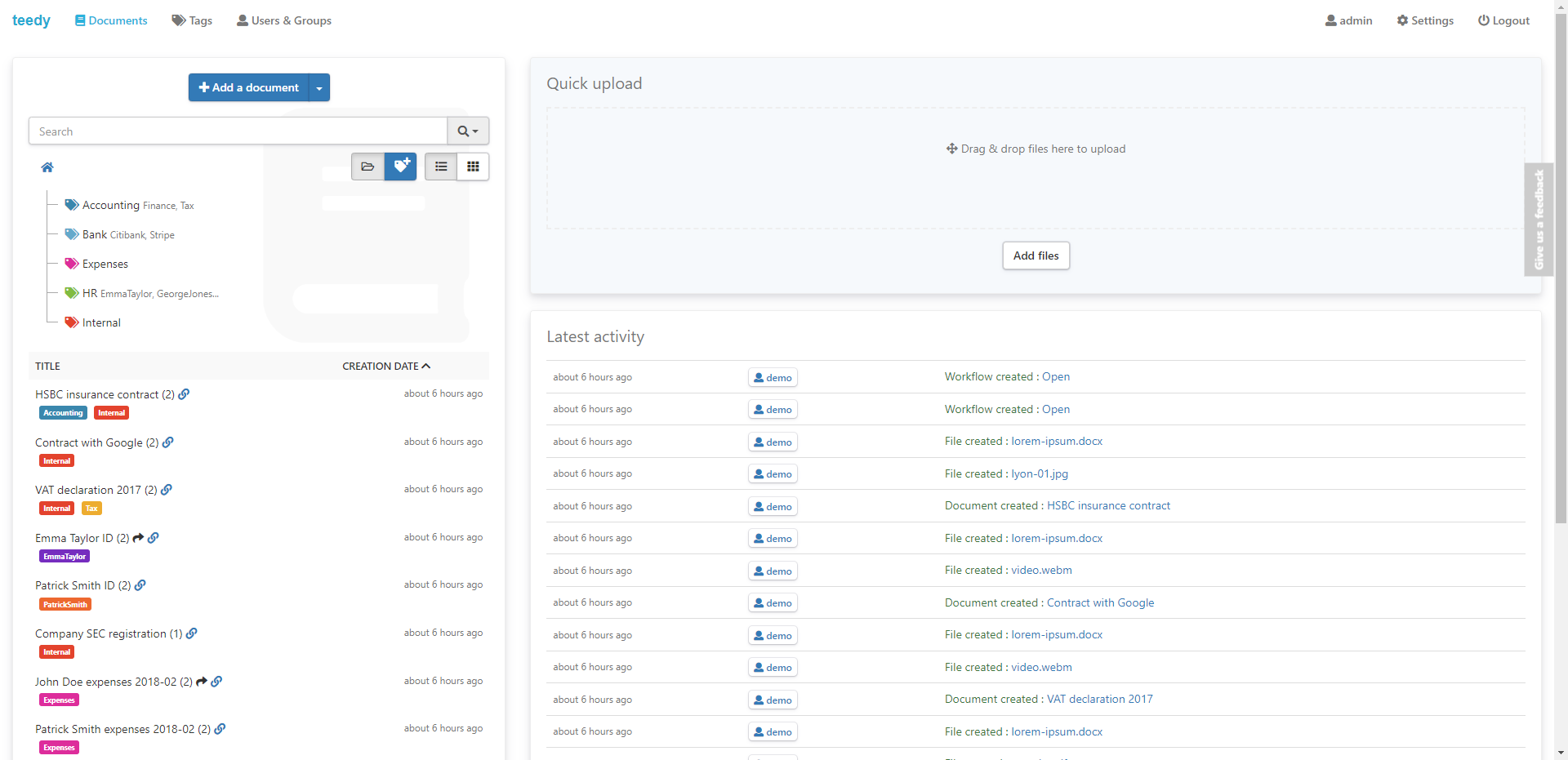
Teedy
Lightweight document management system packed with all the features you can expect from big expensive solutions.
Teedy proves to be quite practical in keeping digital documents well organized. It's straightforward, free from unnecessary complexities and simply does its job effectively. The open source nature of Teedy makes it accessible to individuals seeking digital file organization and small businesses in need of an efficient document management solution. It's a tool worth considering for your document organization needs.
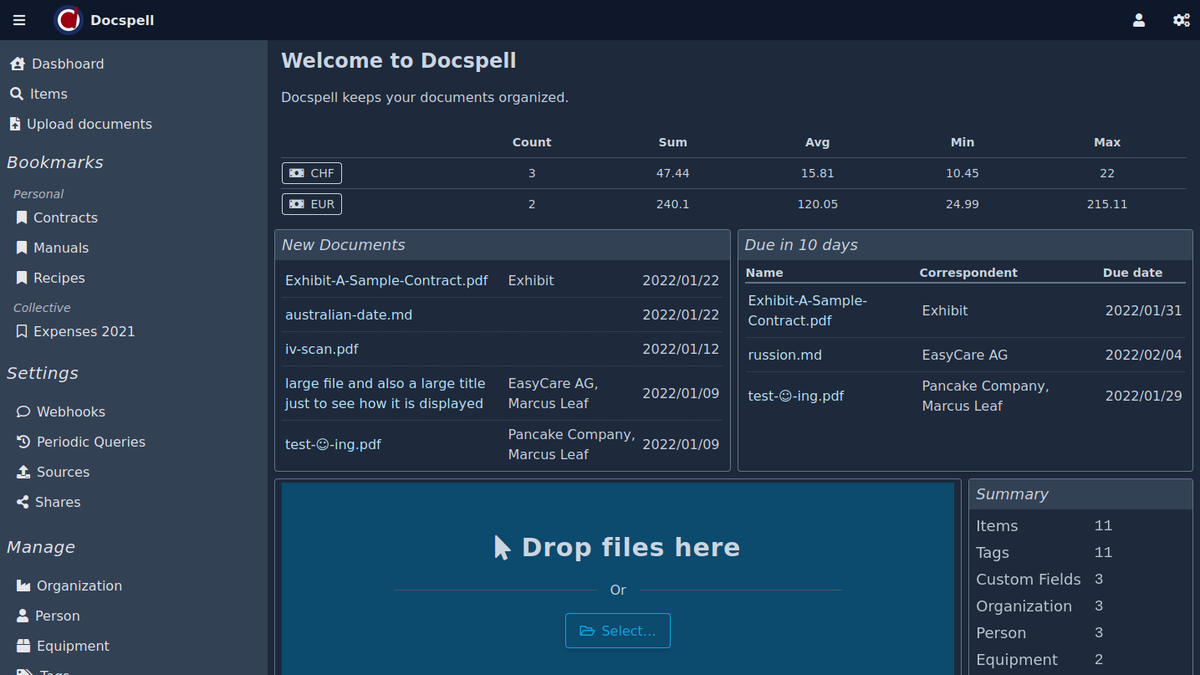
Docspell
Docspell assists in organizing your piles of digital documents, resulting from scanners, e-mails and other sources with minimal effort.
Docspell takes a unique approach by focusing on automatically extracting and attaching metadata from your documents, such as correspondent information, dates, and tags. You can just toss your documents into a digital pile without worrying about where to place them. Later on, you can easily create different organizational structures based on this metadata, making it a breeze to locate any document you need. Docspell even uses OCR (Optical Character Recognition) to analyze text and find information within your documents, further simplifying the process of keeping things organized.
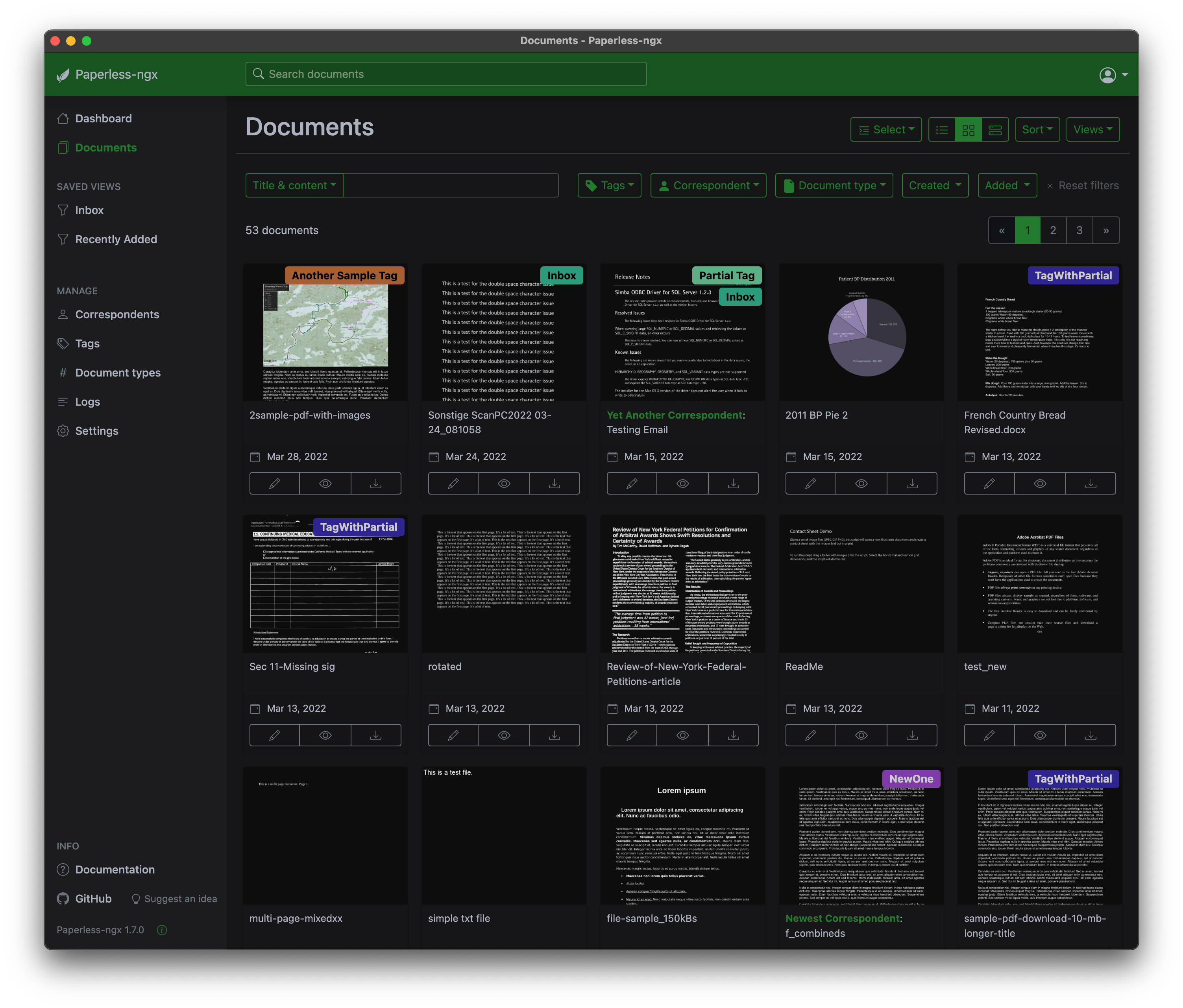
Paperless-ngx
Paperless-ngx is a community-supported open-source document management system that transforms your physical documents into a searchable online archive so you can keep, well, less paper.
Paperless-ngx stands out as a popular choice in the self-hosted community when it comes to managing personal documents. Paperless-ngx has two main components: one that monitors a designated folder and adds your documents automatically, and another that offers a simple web interface for efficiently managing and locating your scanned documents. Each document can be labeled with details like its source, content, and tags for convenient grouping. Unlike traditional folders, Paperless-ngx offers flexibility, allowing a single document to have multiple tags. It also handles date tracking automatically, making document organization effortless and ensuring that it remains a popular choice in the community.
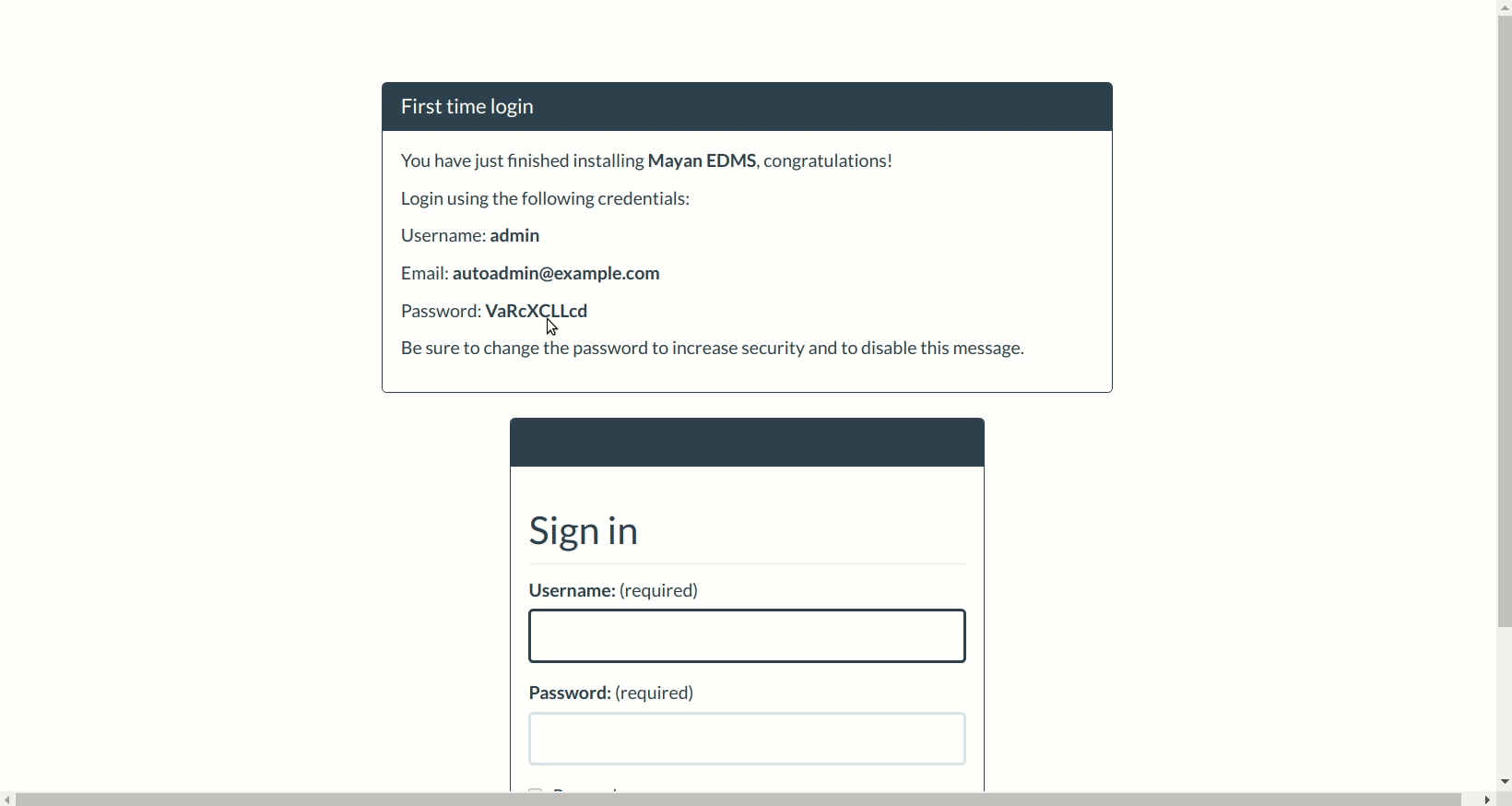
Myan EDMS
Mayan EDMS is a Free Open Source Electronic Document Management System, coded in the Python language using the Django web application framework and released under the Apache 2.0 License. It provides an electronic vault or repository for electronic documents.
Mayan EDMS was originally a project to store PDFs but has grown into a complete document management system. You can easily upload documents from different sources, organize them with tags, and find what you need using a simple search. Features include customizable metadata, batch uploading, document preview, and version control. It's a resourceful tool for organizing and retrieving your digital documents.
Papermerge is all about collaboration and flexibility. Being open source, it prioritizes transparency and community input, allowing anyone to enhance its source code. It supports multiple users with tailored permissions, and its OCR technology extracts text from scanned documents for easy searching. With a user friendly REST API, you can customize the system to your needs and import documents from various sources. Its efficient full text search lets you find documents effortlessly, and it preserves document versions to prevent data loss.

Sign up for Noted
Maximize Your Homelab Potential with Self-Hosting and Open-Source Solutions.
No spam. Unsubscribe anytime.
Final Notes and Thoughts
I've given all the options above a try, and in the end, I found that Paperless-ngx really suits my personal needs the best. What I appreciate most about it is how easy it is to organize my documents using tags, and the fact that it can automatically keep an eye on my documents folder is a game changer. That's not to say the other choices are without merit, but Paperless-ngx just seems to click better with how I like to manage my documents. It's all about finding the right fit, and for me, Paperless-ngx is the one.
Good evening r/shortfashion . I recently created a rebranded site for short men and would love for some of you to check it out, maybe test it out if you are interested and give some feedback. The vision is a community centered around the short male experience and those who "show love to them" (i.e. friends, relatives, mentors, colleagues, girlfriends, wives, etc). It is open to all. There is some more work to be done, but it is officially live. Free to join and use.
The Site HAS a:
- Community Forum (with category tags)
- Experience Blog (with category tags)
- Fashion Blog (with category tags)
- Marketplace (Buy/Sell/Trade - Clothes, Shoes, Outerwear, Accessories for shorter men)
- Store Links (stores which cater to or are popular with shorter men with ability to review)
- Famous Short Men Gallery (searchable, ability to leave comments)
- Merch Shop
- E-Book Area (eBooks coming, free and non-free titles)
- Members can collect cool badges and gift badges
- Members can award standout posts
- Members can react to posts with emojis to show where they stand
The Site is NOT for:
- Supporting Defeatism (though honesty and constructive language is encouraged)
- Hate (though being HONEST about life experiences and feelings are ABSOLUTELY supported)
A lot of work went into creating this. You could call it a passion project. But as with all sites, maintenance will be its own endeavor. As it is rebranded, there is some more cleanup and some content adjustment to be done. New features will be added over time when I am able to do so. There will be some critics and that's fine, but I felt an independent community like this is missing online. Thanks to anyone who checks it out!
[link] [comments]
We're excited to announce that we've created a new YouTube channel dedicated to Odoo tutorials! We'll be regularly uploading videos to help you master Odoo, whether you're a beginner or an advanced user.
Please check it out and let us know what topics you'd like to see covered. Your feedback and support are greatly appreciated!
https://www.youtube.com/@LogicBridgeSolutions
Happy learning!
[link] [comments]



